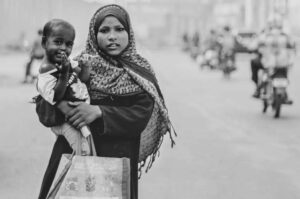
Gender gap a drag on India’s development: What does economic development mean if it leaves behind nearly half the population? This is not a rhetorical flourish but a pressing concern for India — a country often held up as the model for the Global South. With a GDP surpassing $3.9 trillion and visible progress in infrastructure, digital penetration, and welfare schemes, India’s development narrative has undeniable heft. Yet, embedded in this success is a quiet contradiction: persistent gender inequality that undermines both the sustainability and inclusiveness of growth.
India’s record on literacy, health, and physical infrastructure has improved over the years. But aggregate progress masks deep social asymmetries. The Global Gender Gap Report 2025 ranks India 131 out of 148 countries, with only 64.4% of its gender gap closed. Economic participation stands at a low 40.7%, and political empowerment fares even worse at 13.8%. These numbers are not mere indicators — they are symptoms of a systemic failure to translate human development into equitable opportunity.

Women contribute just 18% to India’s GDP, despite accounting for nearly half its population. Over 90% of employed women work in insecure, low-paid, informal sector jobs. According to a 2023 World Bank estimate, closing the gender gap in the workforce could boost India’s GDP by $770 billion by 2025. The issue is not just one of equity — it is about lost economic potential. Market signals alone will not bridge this gap; what is needed is a structural shift in how care work, mobility, and economic agency are conceived and supported.
READ I India’s research publications boom masks quality crisis in academia
Falling behind, despite aspirations
Contrary to expectations, modernisation has not increased women’s participation in the workforce. Female labour force participation fell from 32% in 2005 to below 24% in 2024. Rising household incomes partly explain the decline—the so-called “income effect.” But a host of structural factors play a larger role: restrictive social norms, poor childcare access, safety concerns, inadequate public transport, and the unequal burden of domestic responsibilities.
This regression is especially pronounced in rural and semi-urban areas but also evident among urban, educated women. School and university enrolment have improved, but these gains rarely translate into jobs or leadership roles. The disconnect between education and employment reflects a deeper imbalance—between social arrangements and economic structures.
The invisible economy
Traditional development metrics — GDP and Human Development Index (HDI) — fail to account for this exclusion. GDP tracks what is produced but not by whom or for whom. HDI includes education, income, and health, but not whether women are empowered to convert gains into voice or autonomy. Meanwhile, unpaid domestic labour, overwhelmingly performed by women, remains invisible, despite estimates valuing it at nearly 40% of GDP.
Without recognising, measuring, and redistributing this work, discussions on gender equality will remain rhetorical. Inclusion cannot be bolted on after the fact—it must be built into how the economy functions.
Learning from others
Global evidence is unambiguous: gender equality drives growth, not the other way around. Countries with fewer resources than India have made greater strides through deliberate policy. Rwanda, rebuilding after genocide, reserved more than 60% of parliamentary seats for women. Bangladesh boosted female employment by investing in girls’ education and garment sector jobs. Vietnam’s inclusive labour market reforms offer another example.
Each of these cases reflects a shared principle — Political will matters more than GDP size. Inclusive institutions, not aggregate output, drive sustainable development.
Gaps in institutional response
India’s policy framework has acknowledged the issue, but its response remains fragmented. Schemes such as Beti Bachao Beti Padhao and Ujjwala Yojana have raised awareness but fall short of tackling structural barriers. Gender budgeting, introduced in 2005, has yet to evolve into a robust planning tool. Legal safeguards for workplace safety and equal pay are inconsistently applied — particularly in the informal economy, where most working women remain outside the ambit of regulation.
Basic enabling infrastructure—affordable childcare, safe public spaces, gender-sensitive urban planning — continues to lag. These are not policy luxuries; they are prerequisites for women’s participation in the economy.
Gender gap and the weight of patriarchy
Legal protections like the Maternity Benefit Act and Domestic Violence Act exist, but enforcement remains weak. Patriarchal norms around inheritance, domestic roles, and public participation limit women’s access to both the job market and public life. Laws alone are insufficient. What is needed is enforcement backed by institutional accountability.
The Periodic Labour Force Survey (PLFS) and National Family Health Survey (NFHS-5) offer corroborating data. Women perform over 85% of unpaid household labour, yet this contribution is absent from official employment figures. The Centre for Monitoring Indian Economy (CMIE) reports that just 9% of urban working-age women are employed or seeking work, compared to 67% of men. Rural participation rates show similar disparities. The pandemic only made things worse: as schools closed and caregiving demands rose, women left the workforce in large numbers—often with no path to return.
The economic cost is staggering. The IMF and McKinsey Global Institute estimate that gender parity in the workforce could add $770 billion to India’s GDP—more than most fiscal stimulus packages. The notion that gender inclusion is expensive is false; exclusion is what imposes a heavy economic burden.
Gender gap calls for institutional reforms
Reversing this trajectory will require more than incremental fixes. Gender equality must be embedded as a core development metric, not an afterthought. Budget planning, welfare schemes, and infrastructure investments must be viewed through a gender lens.
There are promising models. Kerala’s Kudumbashree and Maharashtra’s self-help groups demonstrate the transformative potential of treating women as economic agents. But such initiatives must be scaled up and institutionalised.
Workplaces, too, must evolve. Equal pay, robust anti-harassment protocols, parental leave for both genders, and leadership pipelines for women should become standard. The digital gender gap—especially critical in a tech-driven economy—must be addressed. Skill development must cater to women’s time, location, and mobility constraints.
India does not lack talent, a demographic dividend, or democratic institutions. What it lacks is a clear prioritisation of gender equality in economic planning. Unless women are placed at the centre of India’s growth model, the narrative of progress will remain incomplete. Growth that excludes is not just unjust—it is economically unviable.
Sakshi Joshi and Agreima Tyagi are graduate students, and Dr Aneesh KA is assistant professor of Economics at Christ University, Delhi NCR Campus.
